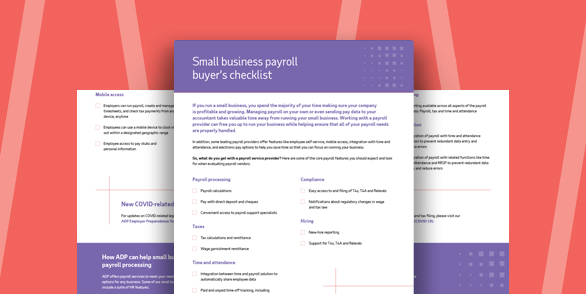Enjoy this article, note ADP Workforce Now On the Go® doesn’t currently include employee benefits
Benefits packages can provide a competitive advantage in the quest to attract and retain talent. That’s why it’s never too early for small business owners and startups to explore employee benefits, especially if they plan on growing their team in the future. This guide serves to help employers better understand the options available to them, as well as some of the requirements.
Offering employee benefits that support employees physical and mental well-being can help maintain employee productivity, boost morale, help reduce absences and protect your business.

What are employee benefits?
Benefits are perks or compensation beyond what employees earn in basic wages. Some organizations view them as intangible business assets that can define an entire corporate culture and indirectly drive overall business success. Others find benefits to be an HR and administrative challenge, but with the right strategy, benefits can be turned into a powerful recruitment, engagement and retention tool. Employee benefits plans help employees cover things that provincial health care plans may not pay for. An organization may cover 100% of the healthcare costs or choose to cover 80%, This can also vary by full-time or part-time, hourly or salaried.
Types of employee benefits
Health benefits are the most basic type of employee benefit. Employers that want to appeal to generational workforces, may need to offer a broad range of perks, such as:
Financial benefits
Employees who are worried about their finances tend to be less engaged at work. Employers can help alleviate their stress and improve their productivity by considering these financial benefits:
- Compensation
When wages become stagnant, workers may start to look elsewhere for employment. Employers can help prevent this turnover by increasing salaries and hourly pay by a fixed percentage each year. Another option is to reward employees based on their performance with cash bonuses or other taxable benefits like profit sharing. - Tuition Assistance
An employer may provide a program for tuition assistance or tuition reimbursement to pay for all or part of an employee's cost to attend classes or other learning curriculum. - Financial wellness programs
Workers who live pay cheque to pay cheque may often have real concerns about covering their monthly expenses. By the time bills are paid, there may be little left to put aside for a child’s education or one’s own retirement. Financial education and counseling services can help employees make informed decisions about how they spend their money, reduce overall debt, and save for the future. - Retirement savings plan
Employers can help their workforce save for retirement by offering an RRSP (registered retirement savings plan). In addition to improving financial security for employees and alleviating their stress, retirement plans can help businesses improve recruiting and retaining talent.
Work/Life Balance
- Time off work – move under work/like balance
Companies have the discretion to offer paid time off, planned time off, or personal time off as a bank of hours. This bank of hours can be used as the employee needs or wants to use the days, and can include sick days, vacation days, mental health and personal days. - Flexible work location options
Companies can decide where they want employees to work on-premises at the company business location, remotely, or a hybrid model. - Mental Health Benefits
Coverage for therapy, access to online subscriptions such as Headspace and other resources that support mental health
Health and wellness benefits
Health and wellness benefits that supplement universal health care might seem like an added expense, but proactively improving employee wellness can often lower health care costs in the long term. Consider providing your employees the flexibility to choose which benefits they want to enroll and those that they can opt out of to ensure that benefits are meaningful for their stage in life. Furthermore, if they opt out then having the flexibility to use those funds for enhanced benefit coverage in specific areas can be a significant benefit to employees.
Some examples include:
- Health
A broad range of benefits are often contained under health including paramedical services like physiotherapy, audiologist, chiropractor, mental health therapy, massage therapy, podiatrist, psychologist, social worker, speech therapy, and more. - Dental
Routine dental exams can help spot not only periodontal disease, but also chronic health issues, like heart disease. Employers typically can choose a variety of basic and comprehensive plans. - Vision
Uncorrected eyesight problems in adults can lead to lost productivity at work, so it often pays to provide a vision plan that includes comprehensive eye exams. Package plans or discount programs help make this insurance coverage more affordable. - Prescription Drug Coverage
Another way to maintain a healthy workforce is to offer prescription drug coverage. Plans with tiered pricing are often more advantageous for employees because they can purchase various prescriptions with a co-pay. - Life insurance
Many people worry about the financial well-being of their dependents if they were no longer there to provide for them. Group life insurance, in which the employer owns a single policy that covers all workers, can provide much peace of mind. Another option is to offer term life or yearly renewable coverage. To keep administration simple, life insurance can be set up as a one-time payment.
Unique employee benefits
Providing more than the traditional medical benefits that employees have come to expect from their employers can help attract and retain talented individuals. The key, however, is to pay close attention to workplace trends and anticipate changing needs as much as possible. Some examples of unique benefits in demand with employees today are:
- Employee assistance programs (EAP)
EAPs can help employees and their immediate family members deal with a host of personal issues. These can include mental health, substance abuse, work-life balance, identify theft and more. Due to the sensitive nature of this subject matter, employees are sometimes hesitant to use the services available to them. Employers may have to communicate the benefits of EAPs and explain that they are confidential to encourage participation. - Pet insurance
Chances are at least some of employees at any business are pet lovers and know the financial and emotional toll of caring for a furry friend. Providing pet insurance as a voluntary benefit can help manage the costs of vaccinations and wellness care, as well as chronic conditions, injuries, and surgeries. - Other unique benefits
These perks may further increase your employee engagement:
- Yoga classes
- Free books
- Pet-friendly environments
- Community hubs to share information and set well-being goals
- Giving Back programs
- Paid days to volunteer
- Charitable matching program
- Active employee resource groups (ERG)
- Fitness
Benefits required for small business
Not all employer-sponsored benefits are optional. Some, such as the following, are required by law and tightly regulated by government agencies:
- Worker safety insurance (Workers Compensation Insurance)
Worker safety insurance operates at the provincial level to protect employers and employees if a workplace accident or illness occurs. It covers the cost of medical care and rehabilitation, as well as a partial replacement of lost income due to disability. The spouse and minor children of employees who die in work-related accidents may also receive a monetary benefit.
Provinces require employers to register for worker safety insurance before hiring their first employee. Failing to do so can result in penalties. - CPP, EI are mandatory benefits that employers are required to provide.
- Legislated Leaves
There are legislated leaves such as, but not limited to, sick, vacation, and parental leaves that are legally required. Small businesses should ensure they are in compliance with these mandatory benefits.
Taxable benefits
Any additional benefits that businesses offer to employees could be considered a source of income and thus, may be taxable, unless they meet certain exclusion criteria. Consult the latest CRA benefits allowances chart to determine what is a taxable benefit.
Importance of employee benefits
Benefits are a vital strategic tool that small businesses can’t afford to ignore, particularly as their operation expands and they try to compete for top talent. Many workers today are looking for flexible rewards and if an employer doesn’t offer options that meets their needs, they run the risk of them leaving for a company that does. In addition to recruitment and retention, competitive benefits packages can help improve employee productivity, engagement, and financial security, as well as the public image of the business.
Yet, simply offering great benefits isn’t enough for businesses to reap the advantages. Employers must make sure their workforce understands what services are available and how to use them. Only through consistent communication and support can they help employees make the most of their benefits plans. Short messages that highlight key action items and use more visuals than text tend to be most effective.
Small businesses are in a great position given their size to consider incorporating creative and meaningful benefits to attract and retain talent such as coverage for home office set up, annual learning grant, subscriptions to mental health apps and fitness collaboration apps such as Sprout.
Frequently asked questions about small business employee benefits
- Do employees need to offer benefits to employees in Canada?
The mandatory benefits that an employer must provide as a minimum to employees include vacation time off, sick leave, critical illness leave, maternity, paternity, parental leave, Canadian Pension Plan contributions, and employment insurance contributions.
Each province have it’s own rules when it comes to specific employee benefits in Canada. Employers should gain advice to ensure they are complying wth the law.
If an employer decides to provide additional benefits as we’ve described here, they must comply with the Employment Standards Act rules against discrimination. - What benefits should a small business offer?
While many benefits are not required, small businesses should consider offering the strongest packages possible. Doing so can mean the difference between attracting and retaining top employees or losing them to competitors. Every business, however, is unique, which is why employers who need help deciding which benefits are right for them should consult with an industry professional.
When deciding on employee benefits for your employees, it is important to consider your employee demographics and future growth plans to select benefits that are relevant to your employee base.




